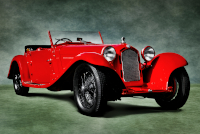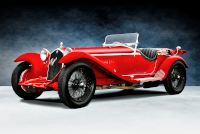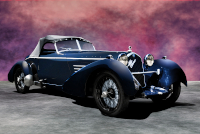Location:
St. Michaels Concours d'Elegance, 2009
Owner: Gale & Henry Petronis | Royal Oak, Maryland
Prologue:
Lean and long, the Figoni-bodied 8C sneaks into the Alfa Romeo register. The car's character is intriguing in that a long-chassis Figoni-bodied Alfa is neither exemplary of the marque's sporting gusto, nor the glorious French style for which the coachbuilder will become known. In contrast, the short-chassis 8C Figoni roadster retains that sporting character, executed with a drip of savvy.
With some consternation over my images and not much support from contemporary sources, I've still stuck with this profile. The 8C 2300 Figoni is a curious mix, and one to more thoroughly explore at some point down the road.
- - - - - - - - - -
► Image Source: Nikon D200 (10.2 MP)
References:
- UltimateCarPage: Citing two examples of the Figoni-bodied 8C long-chassis, #2111025 and #2311239, by Wouter Melissen, May 24, 2012.
The 8C 2300 cabriolet (or drophead coupe) expresses more aristocratic aspiration than its racing brethren. Many supercharged 8-cylinder Alfas took to lives of high-spirited motoring, if not outright racing. While Touring and Zagato bodied most of these sports cars, a bevy of coachbuilders bodied the 8C as drophead coupes on both long and short chassis platforms. Chassis #2311207 wears coachwork from Joseph (Giuseppe) Figoni, designed in the years prior to his partnership with Ovidio Falaschi.
Because French tax law restricted the import of luxury items, customers with adequate resources could ship disassembled parts into the country, assemble the chassis and drivetrain, then source a local coachbuilder to complete the body. In this manner, Figoni bodied a small number of 8-cylinder Alfa Romeo cars that arrived in France more or less as a complete kit, ready for assembly and fresh bodywork.
Motor: 2,336 cc straight 8-cylinder, aluminum block, aluminum hemi-head | 65 mm x 88 mm | 6.6:1 compression
Valvetrain: DOHC, 2 valves per cylinder, gear-driven via a central mechanism between each 4-cylinder block
Aspiration: Memini twin-choke carburetor, Roots-type supercharger
Power: 155 bhp at 5,000 rpm
Drivetrain: 4-speed gearbox, rear-wheel drive
Front Suspension: beam axle, semi-elliptic leaf springs, friction dampers
Rear Suspension: live axle, semi-elliptic leaf springs, friction dampers
Architecture: pressed steel chassis with coachwork by Joseph Figoni
Kerb Weight: 1,440 kg (3,175 lbs)
Wheelbase: 3,100 mm (122 inches)
Top Speed: 170 km/h (about 106 mph)
Etymology:
'8C 2300' refers to the motor configuration, a straight 8-cylinder of about 2.3 litres displacement. 'Lungo' denotes the lengthier 3,100 mm wheelbase. 'Figoni' denotes the work of Giuseppe Figoni, the Italian transplant of Paris who later expressed Art Deco styling under the banner of Figoni et Falaschi.
Figures:
Various internet reports cite that Alfa Romeo built anywhere between 188 and 195 8C 2300 cars. The Alfa factory cites over 300 8C 2300 cars built from 1931 to 1934. Alfa Romeo built these 8C 2300 cars in three series. Owing to the tax laws that restricted automobile import, Figoni bodied only a handful of 8C Alfas, perhaps around seven drophead coupes, in addition to a small number of short chassis cars. Current research uncovers no more than five of these long-chassis drophead coupes.
Early Years: A Late Independent Figoni Design
By 1933, Giuseppe Figoni neared the end of his time as an independent coachbuilder. In another year or so, his partnership with Ovidio Falaschi will create a French styling house both revered and rebuked for its ostentatious turns of Modernist fashion. In these early years, Figoni dabbled in style, but remained conservative. For example, this 8C 2300 exhibits a straightness of line and staunchness of character uncommon for a classic Italian sports car.
Puritan Sentiments: Incidental English Themes in the Figoni 8C Alfa
The effect of this 8C 2300 is almost English, much like a contemporary Alvis, with stout corners and broad flanks. The bonnet features plainly rendered louvres, the hood a simple, folded affair. The lack of panel accents does no service to the coachbuilder's reputation, whereas other chassis found online, #2111025 and #2311239, both display French curves along the flanks and sculpted running gear. In comparison, #2311207 appears puritanical, doing away with ornament in favor of line.
A key difference, however, is the grille shroud, one of Alfa Romeo's own cast pieces with racing-derived vents. The shroud may be the most ornamental feature on the car, a part from the Milanese factory rather than the Paris styling house. And in a way, this reversal of aesthetic priorities underscores the beauty of the design.
The front fenders sweep into the front rails. There, the louvred cowl below the grille forms an integrated cover over the dumb irons, taking the shape of the rails, but not exposing them. Different coachbuilders approached this cowl between the irons in different ways, the objective often to close the visual separation between the chassis and the body.
Moving along the flanks, the shape of the car continues uninterrupted from nose to tail, and the edges of the rear fenders blend discreetly into the tail. The coachwork feels like fire-engine red fondant on a wedding cake, rolled in a single sheet and then draped evenly over a form. All of the corners are just slightly softened so that, rectangular as the car is, the angles seem gentle. And so this design is about proportion and finesse, not ornament.
Last Updated: Mar 26, 2025








